Chapter 8. Classification According to Payload
“ I think computer viruses should count as life. I think it says something about human nature that the only form of life we have created so far is purely destructive. We've created life in our own image.”
—Stephen Hawking
This chapter describes the most common computer-virus activation methods. Computer viruses can use an endless number of events to trigger their activation routines. Common examples of such events include, but are not limited to, the following basic methods:
• System date or time
• A particular file's file date stamp
• A particular filename
• The default language setting of the system
• The name of a visited Web site
• The system's IP address
• The operating system used
• A particular vulnerability that only exists in a certain version of an operating system, such as Russian Windows versions.
Even targeted virus attacks are now feasible, although general control over virus code replication remains difficult—but not impossible.
8.1 No-Payload
In the layman's world, often everything unusual that happens to a computer is believed to be caused by a “mysterious virus.” In fact, however, most computer-related problems are caused by anything but a computer virus. As a result, IT departments tend to be less and less paranoid, and when real infections explode, they are initially skeptical and waste time. This is the proverbial “crying wolf” situation.
Another problem is that people believe that for something to be classified as a “computer virus,” it needs to destroy user data, such as reformatting the hard disk. People often do not understand why someone would write a program that “only replicates.” In fact, the majority of computer viruses do nothing but replicate. Many proof-of-concept viruses belong to this class, such as the WM/Concept virus. Such viruses might carry a message that is never displayed and is usually left for people who are expected to discover the virus, such as virus researchers. The most boring viruses do not contain any text other than replication code.
Virus replication, however, has many side effects. This includes the possibility of accidental data loss when the machine crashes due to a bug in the virus code or accidental overwriting of a part of the disk with relevant data.
Virus researchers call this kind of virus a no payload virus. However, there is no such thing as a harmless virus. By itself, the replication of the virus can be extremely annoying to the user. I have never met more than a few users who have said to me, “Oh, no problem about these three viruses. They just infect files. I can live with them on my system.” Such thinking seems to be very unusual. Most people feel very stressed by computer virus infections for fear of data loss, among other things. Removal of the virus code can be very costly. For example, when a large software or hardware manufacturing company gets hit by a computer virus, the production of new systems must be stopped, causing millions of dollars of damage during every nonproductive day.
8.2 Accidentally Destructive Payload
Some viruses, such as Stoned, can cause data loss as a result of replication. When the virus saves the original boot sector, it might overwrite important data. For instance, if there are many directory entries on the diskette, Stoned will overwrite some of these entries because it stores the original boot sector at the end of the root directory. As a result, garbage is displayed on the screen instead of filenames when the diskette is looked at with the DIR command. The file can be restored from the diskettes with a disk editor at that point, but most users will experience this as permanent data loss.
8.3 Nondestructive Payload
Almost half of all computer viruses belong to this class. Many computer viruses simply display a message on the screen when they activate. Several such examples are given in previous chapters of this book. Virus writers and malicious code authors are often politically motivated. The WANK1 worm was a typical example of this. This worm was released on the SPAN network on October 16, 1989. The worm replaced the system banner, displaying the message shown in Figure 8.1 when a user logged in on a DEC system.
Figure 8.1. Message released from worm.

Other computer viruses, such as W95/Marburg, have graphical payloads. When Marburg activates, the virus loads the standard IDI_HAND (0x7F01) icon resource, which is used in case of serious error messages, and puts it on the desktop. Finally, it draws up to 256 icons at random positions on the desktop. (See Figure 8.2.)
Figure 8.2. The activation routine of the W95/Marburg virus.
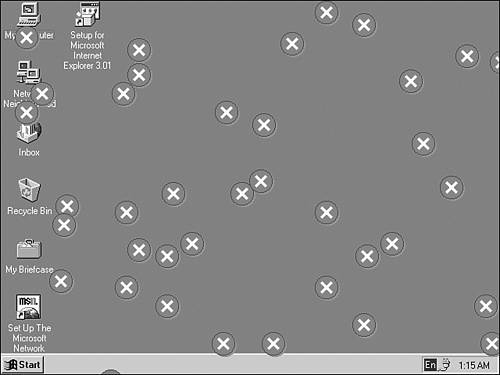
Windows 95 will slowly redraw the desktop area when new windows are moved, causing Marburg's icons to disappear; however, the virus will draw new icons all over again.
Marburg is less annoying than old DOS viruses such as Cascade, which caused the characters to “fall down” to the bottom of the screen in a cascading effect, with some little noise in the background using the PC's speaker.
Other computer viruses have built-in animations that are displayed when triggered. The Hungarian DOS virus, GF6mb (HH&H), displays an impressive 3D bouncing ball.
Probably one of the most infamous people in this category is the French virus writer, Spanska, author of the IDEA virus, which displays several animations, including the one shown in Figure 8.3. All viruses written by Spanska belong to the nondestructive payload category.
Figure 8.3. The activation routine of Spanska's IDEA virus.
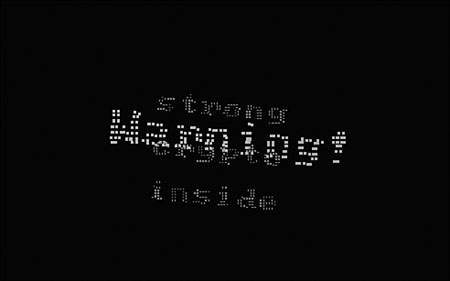
Spanska's most infamous animation is displayed by W32/SKA (also known as the Happy99 worm and discussed in Chapters 3, “Malicious Code Environments” and 9, “Strategies of Computer Worms”). Some viruses are even interactive and play a game with the user. The Playgame virus is an example2.
Of course, viruses are not restricted to displaying animations and messages on the screen. They can use the speaker to play music or even to attempt to speak. On modern computers, playing MP3 or WAV files is no problem, and viruses take advantage of this. Some annoying viruses (and even backdoor Trojan programs) open and close the CD-ROM's door repeatedly, turning a computer lab into a “ghost house.”
Finally, some computer worms even write poetry, such as the W95/Haiku3 virus, written by the Spanish virus writer, Sandman. (See Figure 8.4.)
Figure 8.4. The activation routine of the W95/Haiku virus.

W95/Haiku also connects to 206.132.185.167 (www.xoom.com at the time of the virus attack) and uses the GET command to download a Windows WAV file (/haiku_wav/Haiku.wav). It saves this Windows sound file as c:haiku.wav and plays it. Haiku demonstrates that the actual replicating code does not necessarily need to carry the payload within itself, making the virus much shorter.
8.4 Somewhat Destructive Payload
Other viruses are somewhat destructive. For instance, the W95/HPS virus checks the date during initialization time only, and it will activate only on a Saturday. If a noncompressed Windows bitmap file has been opened, the virus flips the picture horizontally, as shown in Figure 8.5.
Figure 8.5. The activation routine of the W95/HPS virus.
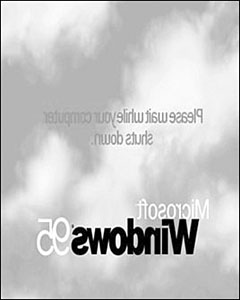
HPS marks these flipped images by patching the ID - DEADBABEh to the end of the bitmap header area to avoid flipping the same image again. Thus, the virus never restores these images. This is somewhat more destructive than the activation routine of the DOS virus, Flip, which flips the characters onscreen but does so only temporarily. Because noncompressed bitmap files are used frequently by Windows, HPS can cause all kinds of weird effects—you need to look at those flipped images in a mirror to make sense of them.
There are some viruses that attempt to target a single executable (most likely an antivirus program). For example, the AntiEXE virus carries a detection string in itself to detect and destroy any executable that contains the string. Other applications are never affected. AntiEXE is most likely a retro virus of an earlier kind. Retro viruses all belong to the mildly destructive class. They attack the antivirus and other security software, such as personal firewall programs, by killing them in memory and deleting them from the disk.
In some cases, retro viruses simply send a “Windows shutdown” message to a selected program, forcing the application to think it needs to exit before Windows shuts down. Of course, Windows will not shut down, but the protection unloads, allowing the execution of any other known attacks that would have been prevented by the installed protection.
Another example of a mildly damaging virus is WM/Wazzu.A. This macro virus was extremely common in 1996 due to the fact that even Microsoft's Web site and a couple of CDs issued by Microsoft were infected with it. Wazzu randomly scrambles three words in documents and inserts the word wazzu into sentences. Morton Swimmer of IBM Research published an entertaining paper on playing the “Where is Wazzu?” game on the Internet using search engines. Because this virus was extremely widespread, many companies published documents on their Web sites that had been mildly damaged by Wazzu.
8.5 Highly Destructive Payload
The most dangerous type of computer viruses will intentionally harm your data or even the hardware in your system. Examples of this type are discussed in this section.
8.5.1 Viruses That Overwrite Data
Many extremely harmful computer viruses simply format the hard drive or overwrite the disk. The Michelangelo virus was among the most infamous of this kind, and the media overreacted to this news. Michelangelo did not attempt to overwrite the entire disk, only parts of the partition (the first 256 cylinders) that system had been booted from. For this reason, it was often feasible to recover data from attacked systems easily.
Over the years, most computer virus researchers have become data recovery experts because of the various kinds of corruption such viruses can cause to a system. Some viruses simply killed the Master Boot Record (MBR) of the system to make them unbootable. This effect was very simple to fix, and Norton Disk Doctor did a particularly good job on its own in many cases. Many data recovery companies charged data restoration by the amount of KBs restored from the hard disk. While it was certainly worthwhile to pay this fee in the case of a real hardware error, it was not cheap to pay for a virus-damaged disk with a corrupted MBR (a single sector).
The Hungarian Filler's damage routine is worth mentioning here. Not only did the virus delete the content of the FAT sectors on DOS, it also filled those sectors with 01 (![]() ) characters, drawing eight similar, large smiley faces in each FAT sector. Thus when you checked to see what happened to the corrupted disk using a disk editor such as Norton DiskEdit, you would find drawings similar to the one shown in Figure 8.6.
) characters, drawing eight similar, large smiley faces in each FAT sector. Thus when you checked to see what happened to the corrupted disk using a disk editor such as Norton DiskEdit, you would find drawings similar to the one shown in Figure 8.6.
Figure 8.6. The graffito of the Filler virus in a FAT sector.
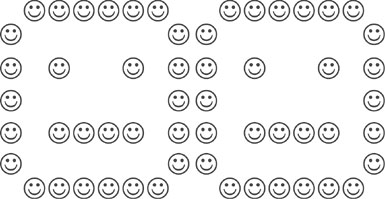
The activation routine of the virus was encrypted in the virus body and has never been documented in international virus descriptions because of this. Instead, the original Hungarian name of the virus, Töltögetö, was translated into English as Filler.
Some other viruses simply delete files. For example, the AntiPascal family targets Pascal programs and deletes them from the disk. Other variants of the AntiPascal virus create temporary files with hidden, system, read-only flags to fill the disk with data and make the system unbootable by manipulating the master boot record.
Unfortunately, some of the successful computer worms such as W32/Witty also used this method to quickly corrupt the content of disks on the attacked hosts—within minutes.
8.5.2 Data Diddlers
The term data diddler was coined by Yisrael Radai. Fred Cohen also used the term to describe viruses that do not destroy data all of a sudden in a very evident form. Instead, data diddlers slowly manipulate the data, such as the content of the hard disk. This kind of corruption is very dangerous because it can easily end up in backups before anyone notices it. Because backups are often reused, all possible data might be corrupt when the virus attack is finally noticed.
Among the first viruses that caused major damage was Dark_Avenger.1800.A, commonly referred to by the nickname Eddie. The virus was so dangerous that the first company I visited in Hungary as a young researcher to collect the virus sample did not even want to talk about it anymore. They simply nailed the remaining infected diskette to the wall as a bad memory of a computer virus attack.
Apparently, Eddie got its name from a text that is not only stored in the virus but is randomly written all around on the hard disk, except on the FAT, causing the slow death of the system. Thus the virus intentionally avoids destroying the FAT so the system will die more slowly and the virus can happily replicate to new systems during that time.
The virus wrote, “Eddie lives…somewhere in time,” on randomly selected sectors of the hard disk. This text could be detected later, but too many files (including databases) would contain it by the time the virus was finally discovered.
Another good example of a data diddler virus is Ripper (which gets its name from Jack the Ripper). Ripper exchanges two data word values in a randomly selected sector and writes back the result to the disk. This is a serious corruption! Furthermore, we have noticed that in some rare cases, such a data-diddler effect can be responsible for minor mutations of computer viruses on Ripper-infected systems. In most cases, a binary virus will be destroyed with this kind of random data manipulation, but in theory such a corruption can lead to a working variant, a tiny mutation that might not be detected by antivirus products using the same definition as they used to detect the original variant. The Russian virus, WordSwap, uses a similar approach and swaps two textual words when files are written to disk.
8.5.3 Viruses That Encrypt Data: The “Good,” the Bad, and the Ugly
The Disk Killer virus was among the firsts to utilized encryption to attack your data. Disk Killer is a boot virus and was first reported in the United States in June of 1989. The virus spread wildly in Europe a few months later. In about 48 hours after the infected system is booted, the virus calls its payload, which displays a message and scrambles the content of the hard disk using a simple XOR encryption, starting at the partition table. As a result, the virus makes the system unbootable. This is what an attacked system would see on screen:
Disk Killer — Version 1.00 by COMPUTER OGRE 04/01/1989
Warning !!
Don't turn off the power or remove the diskette while Disk Killer is Processing!
After the virus has finished running the encryption it displays this message:
Now you can turn off the power.
I wish you luck !
The encryption in the virus was weak, and therefore restoration of the disk was possible using special decryption tools4. The routine, however, contained some minor errors in the cipher code, which made recovery impossible in some cases.
Another boot virus, KOH, was developed in 1993. It uses the IDEA cipher to encrypt the disk and asks the user to type in a password. Although KOH encrypts the disk similarly to Disk Killer, its goal is not to keep users' data hostage or to damage it, but to protect users' data. This is exactly why this virus generated attention and has been discussed as a so-called “good virus.” Mark Ludwig popularized the idea in his book in 19955. Unfortunately, he also made this virus and many others available. Not surprisingly, dozens of variants of the KOH virus exist today6.
Other viruses, such as the Slovakian One_Half that appeared in 1994, use a different technique. One_Half slowly encrypts the disk with a simple encryption method. As long as the virus is active in memory, the disk is accessible to the user because the virus decrypts the encrypted sectors when they are accessed. Finally, after the virus has encrypted half of the disk, it displays the following message:
Dis is one half.
Press any key to continue…
One_Half's disk encryption is a kind of forced symbiosis between the system and the virus. The virus author did not want his creation to be easily removed from the disk. If someone attempts an incompetent manual repair, such as replacing the infected MBR with a clean one, the disk will remain encrypted, and the user will most likely lose his or her data. Several antivirus vendors argued that repairing virus code is sufficient, and such data corruptions should not be the focus of antivirus software. Users saw things differently, however, and antivirus software followed the practice of SAC's (Slovakian Antivirus Center's) repair tool, which decrypted the content of the encrypted sections of the disk and removed the virus from the MBR and the files at the same time.
Similar attacks were also seen on Win32, although with less success. Inspired by the One_Half virus, in December of 1999, the W32/Crypto virus attempted to encrypt the content of the DLLs on the system using the Microsoft Crypto API and strong encryption. This virus, however, contained too many Windows version dependencies and other minor bugs, which caused unwanted system crashes.
Of course, Trojan horse programs such as the AIDS Information Diskette in 1989 already had been used to scramble users' data (as discussed in Chapter 2, “The Fascination of Malicious Code Analysis”), in an attempt to collect a bounty from the users of compromised systems. It was expected that similar attacks would be executed by using an asymmetric cipher. This attack was discussed in a book recently as a “crypto” virus. In fact, the authors of the book claim that they had created such a virus on the Mac in 1996, but “it was a top priority” for them not to release the virus7.
Such crypto viruses use the public key of the attacker to encrypt your data without giving you a chance to decrypt it. Indeed, you would need to pay the bounty to restore your data. In contrast, a simple symmetric cipher easily allows the recovery of the data on the attacked systems because the encryption algorithm (and typically the keys themselves) are stored in the virus, and thus, they can be extracted and used directly to decrypt the data without involving additional secret information held by the attacker.
8.5.4 Hardware Destroyers
Depending on the chipset of the computer and its actual vendor, its Flash BIOS can be updated using software. Nowadays, most PCs use Flash BIOS to update code quickly that would normally be burnt into chips with no chance of a fix. In the early '90s, virus researchers predicted that Flash BIOS would be attacked by computer viruses.
The infamous Taiwanese virus, W95/CIH, successfully killed at least an estimated 10,000 PCs in 1998 by overwriting the boot strap portion of Flash BIOS code. The virus used I/O port commands in kernel mode to access the Flash BIOS. Such port commands could also be executed in user mode, but doing so would have allowed easy protection against the virus's activation routine, and the author of the virus obviously wanted to avoid that.
For instance, a kernel-mode driver could have been loaded on the system to hook the I/O ports that the virus used as an “Open Sesame!” sequence to access the Flash BIOS for write. A VxD could easily capture the request of user-mode code in this way, protecting the machine against such an attack. However, CIH executes the I/O port commands in kernel mode, which another VxD cannot capture and block.
Obviously, a more challenging attack would have been Flash BIOS infection. In fact, such a proof-of-concept virus exists, written by the virus writer Qark in 1994. Fortunately, however, such a virus is fairly BIOS code–specific and hard to implement in a generic way that would support several systems.
Simpler activation routines involve setting a random CMOS (complimentary metal oxide semiconductor) stored boot-up password for the PC. Viruses such as the AntiCMOS family use this trick. The virus takes advantage of the boot protection password, which the user might not be able to change without first uncovering the machine and draining the CMOS battery or, alternatively, clear the content of the CMOS using a jumper setting on newer motherboards.
8.6 DoS (Denial of Service) Attacks
In the past, researchers commonly believed that targeted attacks against selected computers or organizations were not possible using computer viruses. But modern operating systems in the networked world give attackers with political motivations the potential to carry out successful attacks against targeted businesses, such as financial institutions.
There have been several successful DoS attacks in the past, some caused by computer worms. Most of these attacks were not targeted against a particular organization. However, computer worms flood the network with data to such an extent that the side effects of propagation develop into a DoS attack. The W32/Slammer worm was an example of such an accidental DoS attack. The worm was small, and it could propagate itself aggressively on the network. During the outbreak, Internet devices such as routers were heavily overloaded. The result was very unhealthy Internet communications, with as high as 90% packet loss between particular locations. It was difficult to use e-mail during the attack because the network was so slow all around the world. In addition, the speed with which W32/Slammer put packets on the network resulted in ATM failures, canceled airline flights, and election interference8.
On August 14, 2003, several analysts speculated that the W32/Blaster worm was responsible for the major blackout in the United States and Canada. Blaster worm was on the loose for three days by that time. Well, official reports quickly denied these claims.
Indeed, it is believed that Blaster worm was not the primary cause of the blackout. However, Blaster was a potential contributor by slowing down communication systems between electricity control operation centers. Thus the network operators did not have data in time to control the electric systems to avoid further power surges. Clearly, reports indicated that the electricity control center had “computer problems,” which pretty much sound like a worm infection9. Eventually, the east coast experienced power loss, including the area of New York City.
In the end, Blaster worm infections happened so rapidly that vulnerable systems could not be connected to the compromised networks (unless they were protected by a personal firewall) to download the security patches because the worm hit the compromised machine almost immediately. Blaster attempted to attack the Windows Update Web site; however, the attacker failed to pick the right target, so the attack was not successful against the real site. Evidently, a successful attack against the Windows Update site would make it even harder to patch vulnerable systems because the updates would be more difficult to download. Someone could argue, however, that it was hard enough to download the update because vulnerable systems could easily get infected before the patches could be downloaded and installed on them.
On July 16, 2001, the Chinese W32/CodeRed worm attempted to execute a targeted DoS attack against www.whitehouse.gov (with the IP address 198.137.240.91) by connecting continuously to the site. In response to the attack, the IP address was quickly changed. However, the worm carried another payload that targeted systems using U.S. English codepage (0x409).
In such a case, the worm installed a hook routine on the TcpSockSend() function of the INFOCOMM.DLL module of Microsoft IIS. The worm's hook routine did not let an infected system access any HTML content. Instead, the worm displayed the page shown in Figure 8.7 for all Web access.
Figure 8.7. The activation routine of the CodeRed worm.
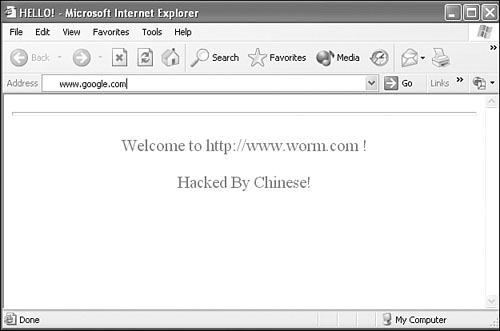
Probably the most infamous worm on Linux operating systems was Linux/Slapper. (Detailed technical information about the previously discussed worms, as well as many others, is available in Chapters 9 and 10, “Exploits, Vulnerabilities, and Buffer Overflow Attacks”.) For the sake of completeness, though, it is interesting to mention here that Slapper was designed to build a peer-to-peer network of compromised systems to execute DDoS (distributed denial of service) attacks. This allowed the attacker to connect to one infected node and control all infected “zombie” systems connected to that node from a single location by sending commands to all at the same time. Each copy of the worm carried a command interface that the attacker could use to execute various types of DoS attacks, including several flooding techniques. Although a few unconnected attack networks were found, the largest network consisted of nearly 20,000 zombie systems waiting for the attacker's commands.
Many other types of DoS attacks were developed in worms. For example, 911 attacks against the phone system are a common payload of computer viruses. (911 is the emergency services phone number in the U.S.) The Neat worm (as discussed in Chapter 3, “Malicious Code Environments”), on Microsoft WebTV systems, was an example of such an attack. The worm simply reconfigured the WebTV system to call 911 instead of the default ISP phone number.
8.7 Data Stealers: Making Money with Viruses
Modern attackers are making money using computer viruses. Although professional attackers could make money by breaking into individual systems to steal credit card numbers and other valuable information, computer worm attacks can reach many more targets in much less time, thereby enhancing the chances that the attacker gets away with valuable information without a trace.
8.7.1 Phishing Attacks
There are several ways to use computer worms to steal information. In the simplest cases, the attacker uses a social engineering attack (also called a simple phishing attack) to collect the information simply by asking you to disclose your credit card information and PIN number. Phishing attacks typically use spoofed e-mail and fraudulent Web sites designed to fool recipients to disclose personal information. Phishers are able to convince up to 5% of recipients to respond to them10.
The W32/Mimail.I@mm11 is an example of such a simple, but rather effective attack. The worms sends itself in e-mail messages. In its attempt to steal information, the worm displays fake dialogs purporting to be from PayPal (see Figure 8.8), which ask you to type in a credit card number and other personal information. The stolen information is stored. Then the information is subsequently encrypted and sent to the attacker.
Figure 8.8. The dialog box displayed by the W32/Mimail.I@mm worm.

8.7.2 Backdoor Features
Computer worms often have built-in backdoors. An infamous example of such a worm is W32/HLLW.Qaz.A. This worm was first discovered in China in July of 2000. QAZ is a companion virus, but it also spreads itself over the network. Furthermore, the worm has a backdoor that will enable a remote user to connect to and control the computer using port 7597.
QAZ enumerates through poorly protected NetBIOS shares and attempts to find a computer to infect. After the remote computer is infected, its IP address is e-mailed back to the attacker. The backdoor payload in the virus awaits connection. This enables a hacker to connect and gain access to the infected computer. According to several sources, QAZ was most likely responsible for successful attacks against Microsoft's networks, compromising a nonsecured home system that had remote connections to corporate sites, thereby allowing the attacker access to valuable information.
Another famous backdoor incident was built into a variant of CodeRed, called CodeRed_II. This worm copies CMD.EXE from the Windows NT System folder to the following folders (if they exist):
C:InetpubScriptsRoot.exe
D:InetpubScriptsRoot.exe
C:Progra~1Common~1SystemMSADCRoot.exe
D:Progra~1Common~1SystemMSADCRoot.exe
Although CodeRed_II spreads as an in-memory injector just like the original, this variant of the worm also drops a Trojan called VirtualRoot. When executed, this Trojan modifies the following Registry key:
HKLMSystemCurrentControlSetServicesW3SVCParametersVirtual Roots
The Trojan adds a few new keys here and sets the user group on these to the value 217. This allows the intruder to control the Web server by sending an HTTP GET request to run scripts/root.exe on the infected Web server. After a successful attack, you can find new root accesses to C: and D: drives in the Computer Management feature of Windows, as shown in Figure 8.9. This allows the attacker full remote access to logical drives C: and D: on the infected computer through legitimate requests to the Web server.
Figure 8.9. System with opened shares after a CodRed_II attack.
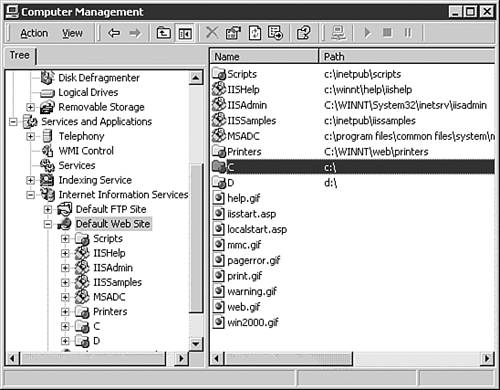
Computer viruses used backdoor features targeting Novell NetWare servers as well. For example, the Hypervisor virus12 on DOS included a special payload to create a Supervisor-equivalent user, called Hypervisor, on Novell NetWare servers in 1995.
Hypervisor waits patiently until the Supervisor of the network logs on from an infected system. At that moment, the virus will be able to add a new user, creating a Hypervisor user object and adding SUPERVISOR SECURITY_EQUALS attributes to it. The Hypervisor user will not have a password set; thus the attacker can log in to the system with Supervisor rights shortly after the virus has been introduced on the local network. Hypervisor also copies the bindery files of Novell NetWare to the SYS:LOGIN/ folder (NET$BIND.SYS, NET$BVAL.SYS on 2.xx servers and NET$OBJ.SYS, NET$PROP.SYS on 3.xx servers). In addition, Hypervisor is a stealth virus.
Computer worms such as Nimda use a similar approach on Windows systems. Nimda adds the Guest account to the Administrator group. This gives the Guest account administrative privileges.
Another example is the W32/Bugbear@mm family, which spreads using a variety of techniques including mass-mailing, network share infection, and file infection. In addition, Bugbear variants support a backdoor component and a keylogger function. Using the keylogger, the worm can collect information that the user types on the system, which can include sensitive data. The worm sends the collected information to several e-mail accounts that belong to the attacker. Using the backdoor component, the attacker can connect to the compromised systems remotely. In addition, some variants of Bugbear specifically target financial institutions. The worm carries a long list of more than 1,000 domain names that belong to banks from around the world. When Bugbear determines that the default e-mail address of the local system belongs to a banking company, it will send the data collected by the keylogger, as well as cached dial-up password information to the e-mail accounts of the attacker. Using the information, the attacker hopes to connect to a financial institution's dial-up network and make financial gain.
8.8 Conclusion
It is very likely that in the future, online fraud will be increasingly common based on computer worm attacks. Not only are banks at risk, but online brokerage systems as well. Imagine the possible financial chaos a computer worm could cause by “buying and selling” online traded stocks. Major stocks often trade tens of millions of stocks a day, but still the stock price hardly changes until the end of the day. Normally, there is a balance between buyers and sellers—not so if computer worms are used to make random or targeted sales and buys in the name of thousands of infected users.
Spammers are increasingly interested to utilize computer worms, bots, and backdoors, providing financial motivation for virus writers to create them.
References
1. Thomas A. Longstaff and E. Eugene Schultz, “Beyond Preliminary Analysis of the WANK and OILZ Worms: A Case Study of Malicious Code,” Computers & Security, Volume 12, Issue 1, February 1993, pp. 61-77.4.
2. Mikko Hypponen, “Virus Activation Routines,” EICAR, 1995, pp. T3 1-11.
3. Peter Szor, “Poetry in Motion” Virus Bulletin, April 2000, pp. 6-8.
4. Fridrik Skulason, “Disk Killer,” Virus Bulletin, January 1990, pp. 12–13.
5. Mark Ludwig, “Giant Black Book of Computer Viruses,” American Eagle Publications, Inc., 1995.
6. Vesselin Bontchev, “Are 'Good' Computer Viruses Still a Bad Idea?,” EICAR, 1994, pp. 25-47.
7. Dr. Adam L. Young and Dr. Moti Yung, “Malicious Cryptography: Exposing Cryptovirology,” Wiley Publishing, Indianapolis, 2004, ISBN: 0764549758 (Paperback).
8. Gerald D. Hill III, “The Trend Toward Non-Real-Time Attacks,” Computer Fraud & Security, November 2003, pp. 5-11.
9. Bruce Schneier, “Blaster and the August 14th Blackout,” http://www.schneier.com/crypto-gram-0312.html.
10. Anti-Phishing Working Group, http://www.antiphishing.org/.
11. Stuart Taylor, “Misguided or Malevolent? New Trends In Virus Writing,” Virus Bulletin, February 2004, pp. 11-12.
12. Peter Szor and Ferenc Leitold, “Attacks Against Servers,” Forraskod, March/April 1995, pp. 2-3.
